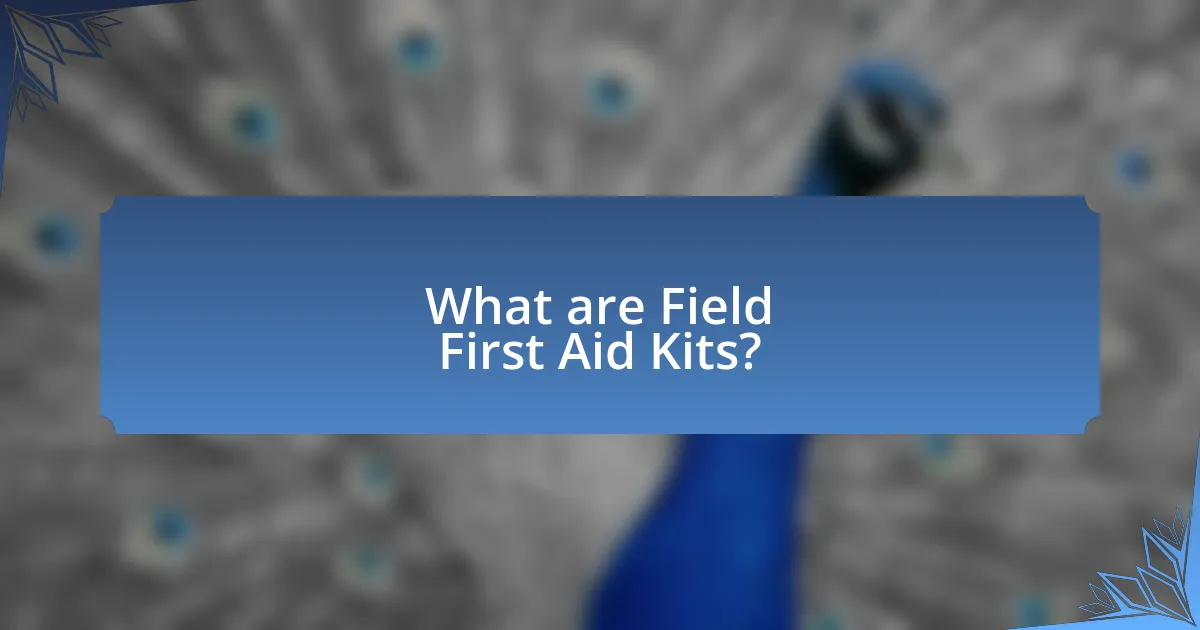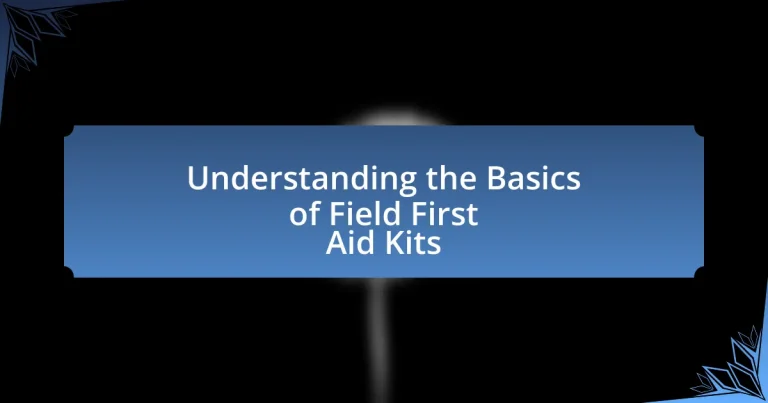Field First Aid Kits are essential portable medical supplies designed for immediate care in remote or outdoor settings, containing items like bandages, antiseptics, and tools for basic life support. These kits are crucial for addressing common injuries encountered during activities such as hiking, camping, and industrial work, significantly improving outcomes by enabling prompt treatment before professional help arrives. The article explores the key components of Field First Aid Kits, their differences from standard kits, and best practices for customization and maintenance, ensuring preparedness for various emergencies. Additionally, it highlights the importance of selecting the right kit based on specific activities and environments, as well as effective usage during emergencies.

What are Field First Aid Kits?
Field First Aid Kits are portable medical supplies designed to provide immediate care for injuries and illnesses in remote or outdoor settings. These kits typically contain essential items such as bandages, antiseptics, gauze, and tools for basic life support, enabling users to address emergencies before professional medical help arrives. The inclusion of specific items is often guided by the environment and potential risks associated with activities like hiking, camping, or industrial work, ensuring that users are prepared for common injuries encountered in those contexts.
Why are Field First Aid Kits essential for outdoor activities?
Field First Aid Kits are essential for outdoor activities because they provide immediate medical supplies and equipment necessary to address injuries and emergencies in remote locations. These kits are designed to treat common outdoor injuries such as cuts, scrapes, sprains, and insect bites, which can occur during activities like hiking, camping, or climbing. According to the American Red Cross, having a first aid kit readily available can significantly reduce the severity of injuries and improve outcomes by enabling prompt treatment before professional medical help is accessible.
What types of emergencies can Field First Aid Kits address?
Field First Aid Kits can address a variety of emergencies, including cuts, abrasions, burns, sprains, fractures, allergic reactions, and minor infections. These kits are designed to provide immediate care for injuries and medical conditions that may occur in outdoor or remote settings. For instance, according to the American Red Cross, a well-stocked first aid kit should contain supplies to manage these common injuries effectively, ensuring that individuals can respond promptly to medical needs before professional help arrives.
How do Field First Aid Kits differ from standard first aid kits?
Field First Aid Kits differ from standard first aid kits primarily in their design and contents, which are tailored for outdoor or emergency situations. Field First Aid Kits typically include specialized items such as trauma dressings, splints, and tourniquets, which are essential for treating severe injuries in remote locations. In contrast, standard first aid kits often contain basic supplies like adhesive bandages, antiseptics, and pain relievers, which are more suited for minor injuries and everyday use. The focus of Field First Aid Kits is on immediate, life-saving interventions, reflecting the need for more robust medical supplies in unpredictable environments.
What are the key components of a Field First Aid Kit?
A Field First Aid Kit typically includes essential components such as adhesive bandages, antiseptic wipes, gauze pads, adhesive tape, scissors, tweezers, and a CPR face shield. These items are crucial for treating minor injuries and stabilizing patients until professional medical help can be obtained. The inclusion of antiseptic wipes helps prevent infection, while gauze pads and adhesive tape are vital for dressing wounds. Scissors and tweezers facilitate the removal of splinters or cutting bandages, and a CPR face shield is important for performing resuscitation safely.
What basic supplies should every Field First Aid Kit contain?
Every Field First Aid Kit should contain adhesive bandages, sterile gauze pads, adhesive tape, antiseptic wipes, scissors, tweezers, disposable gloves, and a CPR face shield. These supplies are essential for treating minor injuries, preventing infection, and providing emergency care. For instance, adhesive bandages and sterile gauze pads are crucial for covering wounds, while antiseptic wipes help to clean the area to reduce the risk of infection. Scissors and tweezers facilitate the removal of splinters or cutting tape, and disposable gloves ensure hygiene during treatment. A CPR face shield is vital for performing mouth-to-mouth resuscitation safely.
How do specialized items enhance the effectiveness of a Field First Aid Kit?
Specialized items enhance the effectiveness of a Field First Aid Kit by providing targeted solutions for specific injuries and emergencies. For instance, items like tourniquets are crucial for controlling severe bleeding, while splints are essential for immobilizing fractures. The inclusion of these specialized tools allows responders to address a wider range of medical situations efficiently. Research indicates that kits equipped with specialized items can significantly improve survival rates in emergency scenarios, as they enable quicker and more effective interventions.
How can you customize a Field First Aid Kit for specific activities?
To customize a Field First Aid Kit for specific activities, assess the unique risks associated with each activity and include relevant supplies. For instance, a hiking kit should contain items like blister treatment, while a sports kit may require additional bandages and ice packs for sprains. Research indicates that tailoring first aid supplies to the environment and potential injuries increases preparedness and response effectiveness, as highlighted in the American Red Cross guidelines.
What considerations should be made for hiking and camping kits?
When preparing hiking and camping kits, essential considerations include the selection of appropriate gear, safety equipment, and personal items tailored to the environment and duration of the trip. The gear should be lightweight, durable, and suitable for the specific terrain, while safety equipment must encompass a first aid kit, navigation tools, and emergency supplies. Personal items should address individual needs, such as medications and hygiene products. According to the American Hiking Society, a well-prepared kit can significantly reduce risks associated with outdoor activities, emphasizing the importance of thorough planning and customization based on the trip’s unique requirements.
How can you tailor a Field First Aid Kit for sports and adventure activities?
To tailor a Field First Aid Kit for sports and adventure activities, include items specific to the types of injuries commonly encountered in these environments, such as adhesive bandages, antiseptic wipes, gauze pads, and splints. Sports and adventure activities often lead to cuts, scrapes, sprains, and fractures, necessitating a kit that addresses these injuries effectively. For example, a study by the American College of Sports Medicine highlights that sprains are among the most common injuries in sports, underscoring the need for elastic bandages and ice packs in the kit. Additionally, including items like a CPR face shield, emergency blanket, and a whistle can enhance safety during outdoor activities.
What are the best practices for maintaining a Field First Aid Kit?
The best practices for maintaining a Field First Aid Kit include regularly checking and restocking supplies, ensuring items are within their expiration dates, and keeping the kit organized for quick access. Regular inspections should occur at least every six months to identify any missing or expired items, as research indicates that 30% of first aid kits are found to be incomplete or outdated during routine checks. Additionally, storing the kit in a designated, easily accessible location enhances response time during emergencies. Proper training on the use of the kit’s contents is also essential, as it ensures that individuals are prepared to administer aid effectively when needed.
How often should you check and restock your Field First Aid Kit?
You should check and restock your Field First Aid Kit at least every three months. Regular checks ensure that supplies are not expired and that essential items are available when needed. According to the American Red Cross, first aid kits should be inspected periodically to maintain readiness for emergencies, emphasizing the importance of having up-to-date supplies.
What are common mistakes to avoid when managing a Field First Aid Kit?
Common mistakes to avoid when managing a Field First Aid Kit include failing to regularly check and restock supplies, neglecting to ensure that all items are within their expiration dates, and not tailoring the kit to specific environmental or activity-related needs. Regular checks are essential because supplies can deplete or expire, which compromises the kit’s effectiveness in emergencies. Additionally, a one-size-fits-all approach often leads to missing critical items that are relevant to particular situations, such as outdoor activities or specific injuries. Proper management ensures that the kit remains functional and ready for use when needed.
How can you effectively use a Field First Aid Kit in an emergency?
To effectively use a Field First Aid Kit in an emergency, first assess the situation and identify the type of injuries or medical issues present. This allows you to select the appropriate supplies from the kit, such as bandages for cuts, antiseptic wipes for cleaning wounds, or splints for fractures. According to the American Red Cross, having a well-stocked and organized first aid kit can significantly improve response times and outcomes in emergencies, as it ensures that essential items are readily available and easily accessible.
What steps should you follow when administering first aid using the kit?
To administer first aid using a kit, first assess the situation and ensure safety for yourself and the injured person. Next, gather the necessary supplies from the first aid kit, such as bandages, antiseptics, and gloves. Then, provide care based on the specific injury or condition, such as applying pressure to a wound or performing CPR if needed. Finally, monitor the person’s condition and seek professional medical help if necessary. These steps are essential for effective first aid, as they prioritize safety, proper care, and timely medical intervention.
How can you ensure proper communication during a medical emergency?
To ensure proper communication during a medical emergency, establish clear and concise communication protocols among all individuals involved. This includes designating a specific person to relay information to emergency responders, using simple language to describe the situation, and providing essential details such as the nature of the emergency, the location, and the number of individuals affected. Research indicates that effective communication can significantly improve response times and outcomes in emergencies, as evidenced by a study published in the Journal of Emergency Medical Services, which found that clear communication reduces confusion and enhances coordination among responders.
What are some tips for choosing the right Field First Aid Kit?
To choose the right Field First Aid Kit, prioritize the specific needs of your environment and activities. Assess the potential injuries or emergencies that may occur based on the location, such as outdoor sports, hiking, or remote work settings. Ensure the kit includes essential items like adhesive bandages, antiseptic wipes, gauze pads, and a CPR face shield, as these are commonly required for treating minor injuries. Additionally, verify that the kit is compact, waterproof, and easy to carry, which enhances accessibility during emergencies. Research indicates that a well-stocked first aid kit can significantly improve response times and outcomes in emergency situations, making it crucial to select one tailored to your specific requirements.
What factors should influence your selection of a Field First Aid Kit?
The selection of a Field First Aid Kit should be influenced by the specific environment, the types of injuries likely to occur, and the number of people it will serve. The environment dictates the kit’s contents; for example, a wilderness setting may require items for snake bites or severe weather conditions. The types of injuries anticipated, such as cuts, burns, or fractures, determine the necessary supplies, while the number of users affects the quantity of items needed. According to the American Red Cross, a well-stocked kit should include bandages, antiseptics, and tools tailored to the specific risks of the field environment.
How can you evaluate the quality of a Field First Aid Kit before purchase?
To evaluate the quality of a Field First Aid Kit before purchase, examine the contents, certifications, and durability of the kit. High-quality kits typically include a comprehensive range of medical supplies such as bandages, antiseptics, and tools for various emergencies. Look for kits that meet recognized standards, such as those set by the American National Standards Institute (ANSI) or the Occupational Safety and Health Administration (OSHA), which ensure that the kit contains essential items for first aid. Additionally, assess the materials used in the kit’s packaging; durable, waterproof cases are preferable as they protect the contents from environmental factors. Checking customer reviews and ratings can also provide insights into the kit’s effectiveness and reliability in real-life situations.

